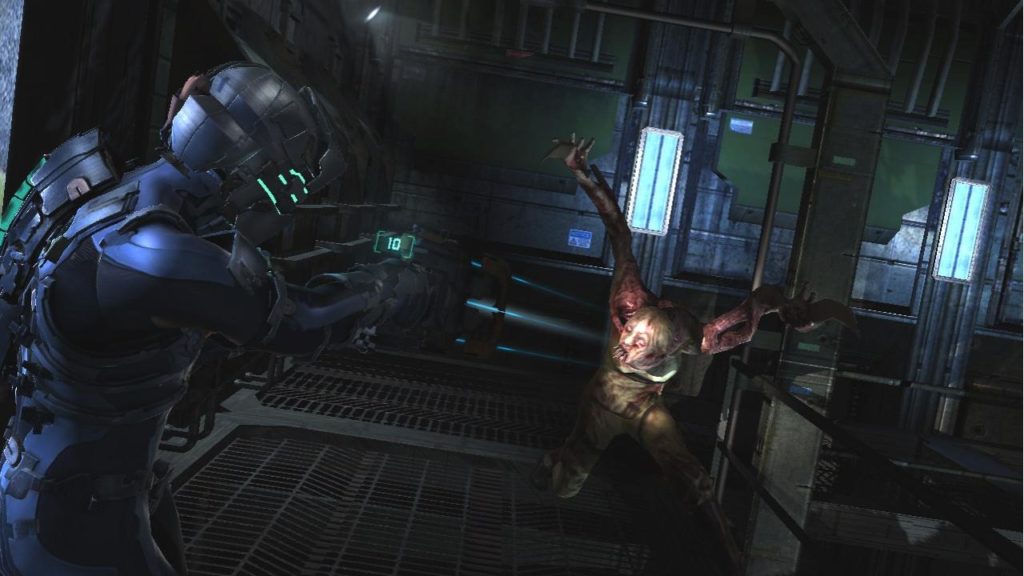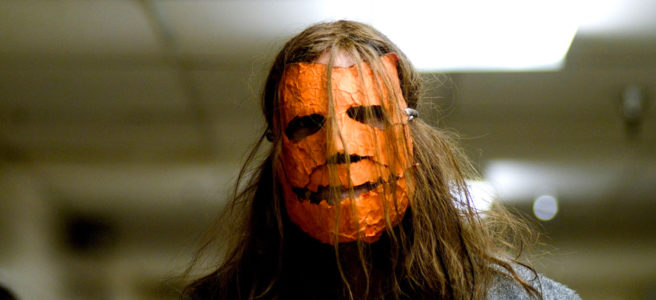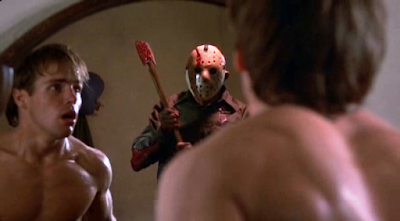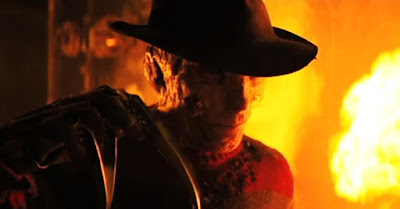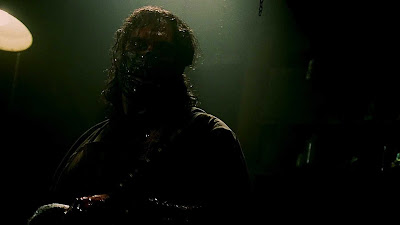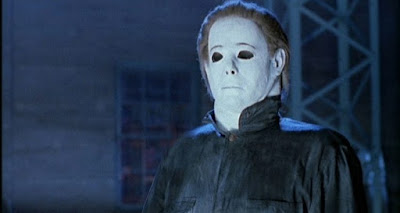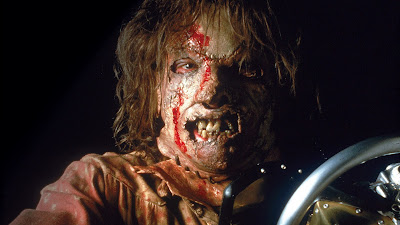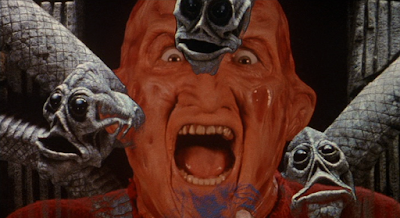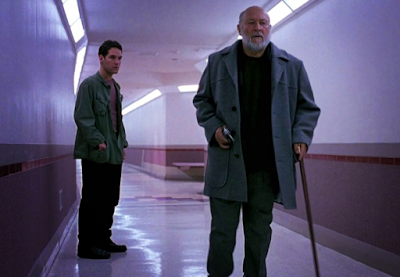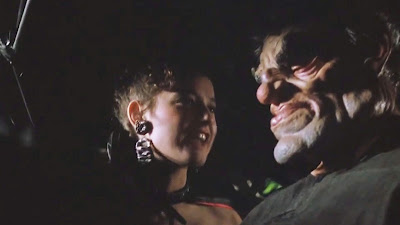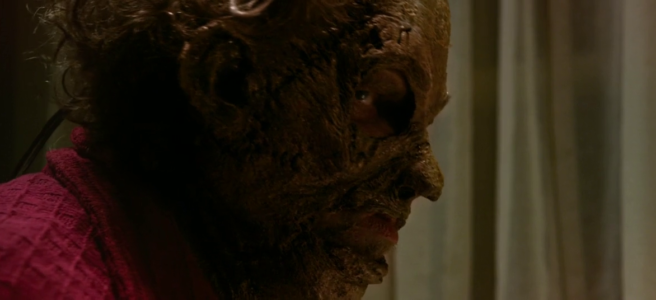Welcome back to The Texas Chainsaw Massacre retrospective! In today’s entry we’re going to be looking at the seventh entry in the franchise, 2013’s Texas Chainsaw 3D! Despite the success of the Platinum Dunes remake and its less-successful prequel, new rightsholders Lionsgate aimed to create a follow-up on the original film, ignoring all of the other films in the franchise in the process. Would this back-to-basics approach finally allow the franchise to find its footing? Read on to find out…
Not particularly enthused by this poster, but the tagline “Evil wears many faces” is great, love it.
PRODUCTION
After The Texas Chainsaw Massacre: The Beginning‘s profitable, but disappointing box office numbers, Platinum Dunes and New Line had no interest in producing another film in their remake franchise. As a result, the rights reverted to Bob Kuhn and Kim Henkel, who entertained offers to produce new films in the franchise. In late 2009, Twisted Pictures and Lionsgate purchased the rights to the franchise, and signed a deal to produce several new films (the number of films planned ranged from five to seven). More details emerged in early 2011 when Lionsgate partnered with Nu Image films to help produce the film, which was going to be shot in 3D. 3D was, of course, the big trend at the time. Following the box office success of Avatar, films such as Clash of the Titans began converting to 3D in post-production and experienced a box office bump as a result (although such shoddy 3D conversions would ultimately lead to major audience fatigue with 3D due to the poor quality). After seeing that 3D meant big business, many films began being shot and released in the format, such as the horror comedy Piranha 3D.
John Luessenhop was hired to direct, having just come off of the relative success of the Matt Dillon-starring armoured truck heist film Takers (not to be confused with the other Matt Dillion-starring armoured truck heist film that had come out the year before, Nimród Antal’s Armored). It was announced that the new film would be a direct sequel to the original film and would ignore the events of the sequels and remake. Debra Sullivan and freaking Adam Marcus (most famous for being the writer and director of the flat-out worst Friday the 13th film, Jason Goes to Hell) were brought on board to write the script for the film. According to Adam Marcus, the original intent was to explore Leatherface’s relationship to his family and to fill out some mythology for him, much like what he did with Jason Voorhees (and failed spectacularly at, which I can’t stress enough). He also intended to set the film in the ’90s (in a cheeky bit of meta-text, it was intended to be set around the release date of Jason Goes to Hell). The film was also designed as more of a monster movie, rather than a slasher film, which would give Texas Chainsaw 3D a different sort of feel within its franchise. However, after Kirsten Elms and Lussenhop took the script for rewrites, someone high up in the production decided to change the film’s setting to the modern day at the last minute, even though the film had already been cast with characters aged for a ’90s setting. As a result, the actors are all inexplicably 20 years too young, a major plot whole which basically every review of the film will point out. Presumably, the person in charge of that decision just assumed that audiences wouldn’t notice or care, but it’s really obvious and dumb when you watch the film.

Speaking of the cast, Texas Chainsaw 3D brought back a number of classic Chainsaw cast members for cameo roles. Most notably, Marilyn Burns and Gunnar Hansen both returned to play Verna Sawyer-Carson and Boss Sawyer, respectively. This was Hansen’s last film appearance before his death in 2015, and one of Burns’ last roles before her death in 2014. Bill Moseley also returned to play Drayton Sawyer in the film’s opening scene, playing tribute to the late Jim Siedow who had died in 2003. John Dugan was the only returning actor to reprise his role from the original film, having played Grandpa Sawyer way back in 1974. As for the new cast, the gorgeous Alexandria Daddario was cast in the lead role of Heather Miller, while the role of Leatherface went to Dan Yeager in his first major role. Notably, Scott Eastwood was also cast as a local policeman named Carl. As for the other leads, rapper Trey Songz was cast as Ryan, Tania Raymond as Nikki, Keram Malicki-Sánchez as Kenny and Shaun Sipos as the hitchhiker Darryl. Other notable cast included Paul Rae as the villainous Mayor Burt Hartman and Thom Barry as the not-so-subtly named Sheriff Hooper.
Filming began on July 18, 2011 in Shreveport, Louisiana during a traditional Chainsaw heatwave and would continue for six weeks. A big deal was made about the crew recreating the Sawyer house, using the original film to try to match all of the details as closely as possible. It was supposedly so accurate that Gunnar Hansen’s only note was to move a chicken cage over a few feet when he arrived on set. Luessenhop shot the film using state-of-the-art Red Epic cameras. The film was also shot on a very low budget (around $11 million), which made production particularly difficult at times and forced the cast and crew to work on a 24-hour schedule towards the end to get everything completed in time. The film was originally scheduled to release in October but was pushed back to January 4, 2013 by the studio for, according to Luessenhop, “stictly business decisions”. This delay may have been, in part, because when the film was submitted to the MPAA, it received an NC-17 rating for extreme violence and had to be re-cut.
PLOT SYNOPSIS
Texas Chainsaw 3D opens with a quick rundown of scenes from The Texas Chain Saw Massacre, before cutting into the police arriving at the Sawyer house. A group of Sawyers arrive just before them and hurry to defend the house, but Sheriff Hooper demands only Leatherface to be released to them. The Sawyers agree to Hooper’s terms, but then a lynch mob led by Burt Hartman arrives and begin to shoot at the Sawyers and set the house on fire. The family is massacred and the only survivor found is Loretta Sawyer and her newborn baby, Edith Rose Sawyer. However, one of the lynch mob members named Gavin Miller kills Loretta and then takes Edith as his own daughter, renaming her Heather Miller.

Jumping ahead to the present day, a somehow-not-40-years-old Heather Miller receives a letter in the mail saying that she has an inheritance from a long-lost grandmother. This causes her to realize that she was adopted and that her birth name is Sawyer, facts which her parents had been keeping from her. Her roommate, Ryan, along with their friends Nikki and Kenny all decide to accompany Heather to Texas to pick up the inheritance. Along the way, they pick up a hitchhiker named Darryl.
When they get to Texas, they meet a lawyer named Farnsworth who reveals that Heather’s grandmother, Verna Sawyer-Carson has left an entire mansion to her. He also leaves a letter from Verna, telling Heather that she needs to read it. The group then heads into the mansion to explore and take in all the opulence. Darryl volunteers to cook dinner for the group while the rest go into town to get supplies, but as soon as they leave Darryl starts to rob the house of all the valuables he can find. In his rummaging, he finds a hidden passage into the basement and comes across a large, locked door. Assuming he came across the jackpot, he tries to break inside, but all he finds is Leatherface, who beats his skull in. Meanwhile, the group get some supplies in town and Heather meets a local cop she takes a fancy to named Carl. She also meets the town’s mayor, Burt Hartman, who she tells that she has inherited the Carson Mansion because she is a Sawyer. Hartman is clearly troubled by this revelation and tries to get Heather to leave town unsuccessfully.
When the group returns to the mansion, they realize that Darryl had robbed the house and think that he has already escaped. Rather than letting that get them down, the group tries to make the most of the situation and begin partying. Everyone begins going their separate ways, with Heather checking out the graves of her family, Kenny begins cooking and Nikki manages to seduce Ryan in the barn. While everyone is busy, Kenny finds the secret passage and begins exploring, but is captured by Leatherface. When Heather returns to the house, she finds the exhumed corpse of Verna in an upstairs bedroom and begins freaking out. When she runs back downstairs she finds Leatherface in the kitchen cutting fingers off of Darryl’s dismembered hand. This causes Heather to freak out even more and Leatherface captures her and takes her to the basement. He then puts Kenny on a meathook and chainsaws him in half. After witnessing her friend’s death, Heather flees the basement and Leatherface pursues her out of the house. Heather tries to hide in Verna’s empty casket, but Leatherface finds her. He is about to kill her when Ryan and Nikki distract him. Heather gets into the group’s van and rescues them from the barn, but Leatherface chases them, damaging the van and causing it to crash. The crash kills Ryan when a giant piece of glass gets embedded in his neck and then Leatherface attacks and badly injures Nikki. Before he can kill her, Heather taunts Leatherface and makes him chase her to a nearby carnival. Leatherface chases Heather through the carnival until Carl confronts him, but Leatherface throws his chainsaw at the officer and flees back towards the mansion.
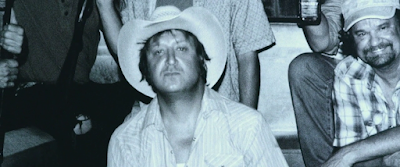
Heather is taken to the police station for a statement with Sheriff Hooper, but Mayor Hartman comes bursting in, realizing that Leatherface is still alive after all these years. Heather gets left alone in a room full of evidence from the chainsaw killings, which causes her to realize that the lynch mob led by Hartman (and including her adopted parents) massacred her whole family, including her mother. Meanwhile, Hartman and Hooper watch a cell phone video feed from police officer Marvin (who was also present at the lynching), who has entered the Carson Mansion alone. He follows a trail of blood into the basement, where he finds the mutilated bodies of Kenny, Ryan and Darryl and hears a rumbling from a nearby meat freezer. He opens it up and Nikki pops out, which startles Marvin and causes him to accidentally shoot her in the head. Hartman orders Marvin to exit the house and then tells Hooper to help him arrest Heather, since she’s a Sawyer and must be in on this. The pair find that Heather has left the station, writing “MURDERERS” on a photo of the lynch mob. Leatherface then attacks and kills Marvin with a hatchet before skinning his face for a new mask.
Meanwhile, Heather contacts Farnsworth and the pair meet at a bar. Farnsworth explains that Leatherface is her cousin and that she was supposed to let him know that she’s his family as Verna before she died had told him to expect Heather. Hartman then bursts into the bar and assaults Farnsworth while Heather escapes, where she is found by Carl. She tries to get Carl to take her back to the mansion, but Carl reveals that he is Hartman’s son and that he is going to take her to the old slaughterhouse to be eliminated. Leatherface hears this on Marvin’s police radio and heads out to get revenge on them.
At the slaughterhouse, Heather is tied up until Hartman can arrive, but when Carl leaves to see his father, Leatherface shows up and prepares to kill Heather. However, Heather’s shirt had been torn open while struggling away from Carl and Leatherface sees a burn on her breast in the shape of the Sawyer family “S” medallion. Realizing that she is his cousin, Leatherface cuts her free as Hartman and another member of the lynch mob, Ollie, arrive and disarm him. Heather flees, but stops when she realizes that Leatherface is the only family she has left and decides to rescue him. Hartman has chained up Leatherface and is preparing to drop him into a meat grinder, but Heather stabs Ollie and then throws Leatherface his chainsaw. Leatherface frees himself and then gets into a brief crowbar-vs-chainsaw battle with Hartman, which predictably ends when he chainsaws Hartman’s legs off and then backs up him up towards the meat grinder. Hooper arrives on the scene and Hartman begs him to shoot Leatherface, but Hooper has a crisis of conscience and decides that Hartman was wrong to kill the Sawyers in the first place. Hartman is then forced into the meat grinder and killed. Heather and Leatherface return to the mansion, Heather finally having found her family. And in a post-credits stinger, Heather’s adopted parents arrive at the mansion and then are presumably killed by Leatherface.

REVIEW
In many ways, Texas Chainsaw 3D is the biggest and boldest reinvention this franchise has seen since Texas Chainsaw Massacre 2. Every other film in the franchise has followed a pretty similar mould: a group of people heads down to Texas, something unfortunate happens which strands them, they get chased by a family of chainsaw killers, there’s a dinner scene, then the final girl gets away. Texas Chainsaw 3D shakes things up immediately by featuring footage from the original film in the opening credits and then seamlessly cutting to new footage which picks up where that film left off. You can, of course, notice the difference since the new footage is shot on much higher quality film stock (which is particularly embarrassing when they replace footage of Jim Siedow with Bill Moseley), but I really must say that the crew did a great job of recreating the Sawyer house. All of the little details have been captured very well, even just seeing the police car passing by the abandoned transport truck made me giddy. They even did a pretty good job of recreating Leatherface’s pretty lady mask, which is extra impressive when you consider just how difficult this series has found it to come up with decent looking masks. This whole sequence lasts about ten minutes and is by far the most distinctive aspect of the film. From there, the film turns into more of a gothic tale as Heather tries to understand her long-lost family before Leatherface emerges and begins hunting everyone.
That said, while I can appreciate that Texas Chainsaw 3D was trying to do something different, holy shit is this movie ever stupid. I’ll get the obvious issue out of the way first – not setting this film in the ’90s was perhaps the dumbest decision made in the production of this film. All of the characters are far too young for a modern day setting, and while Heather is the most egregious, the film also suffers because Sheriff Hooper, Burt Hartman and the other members of the lynch mob are all played by the same actors in both timelines. As a result, they really don’t look like they’re the right age in either timeline and it really strains the suspension of disbelief to think that some of them have held down the same jobs in the same town for 40 years now. It’s just insulting that the filmmakers didn’t think anyone would notice or care about this issue, but it instantly breaks any internal logic for the film.
Still, even if the timeline didn’t make any sense, there are a whole load of other fundamentally stupid problems with this film. For a film which is so superficially reverential to the original Chainsaw, it sure does ignore obvious elements of that film in order to make their movie work. By far the dumbest aspect of the story is that the film wants us to sympathize with the Sawyer family… by completely ignoring that they’re a bunch of psychopaths. I’m not kidding, the film tries to pretend like it was only Leatherface who was involved in the unprovoked killing of Sally’s friends, not to mention all the people Nubbins has helped kill and that Drayton has turned into freaking BBQ. It’s not even like Heather wouldn’t have known this, she finds the box of evidence about the Sawyer family’s crimes and their mass killing by the lynch mob. You’d think that maybe she’d think “well that sucks, but I guess they kind of had it coming…” As the film goes on further they act like the lynching was the real crime that happened here, not the Sawyers’ grave robbing, cannibalism, torture and murder which led to the mob attacking them in the first place. Sheriff Hooper even refuses to stop Leatherface from murdering Mayor Hartman because he feels like the Sawyers were treated so unjustly, holy shit! Like… I have no words for how stupid this is. Were they planning on making it a twist in one of the six sequels this film was supposed to get that Heather finds out that her family were all psychos, not just the psycho she lives with now? Somehow I seriously doubt it, because again the filmmakers just assume that we won’t notice or care. That’s not even the only stupid aspect, we’ve also got the whole notion of Verna Sawyer-Carson, which goes against what was established in the original Chainsaw. Wasn’t the whole point of the first Chainsaw that the Sawyers are on hard times because their livelihood has dried up, hence why they’re killing in the first place? You’re telling me that they had a really tight-knit family clan with a super rich relative living nearby who could have helped them out? Even more stupidly, she’s apparently Leatherface’s mother, so if they were on times so hard that they begin murdering people, you’d think she’d help them out. Bloody hell Adam Marcus, you suck at expanding a series’ mythology in a manner which is consistent with that series’ basic, established canon.

Then there’s all sorts of little dumb moments peppered throughout the script, often for plot convenience. Like, in addition to ignoring the whole “Sawyer family are all psychos” bit, Heather just forgives and forgets that Leatherface killed her friends when she finds out that he’s part of her family. Apparently it’s totally okay to be a murderer as long as you’re out to murder people other than me, right? They even contrive elaborate scenarios for Darryl, Ryan and Nikki’s deaths to shunt some of the blame away from Leatherface (although Kenny still gets chainsawed in half, so…). Then there’s the fact that Burt Hartman is apparently as much of a psycho as the Sawyers, hating anyone named “Sawyer” so much that he’ll fly into a murderous rage and assault a freaking lawyer in a public place. Again, this man is the freaking mayor of a small town, what the hell is he so fussed about? Why did they even leave the evidence lying around where Heather could find it and piece together her family’s history with the Hartmans? Hell, why did the locals even lynch the Sawyers, it’s not like Sally was one of their family members anyway? There isn’t really any motivation for them to hate the family so obsessively, you’d think that there’d be something to trigger this feud in the first place. On the smaller end of things, there’s also apparently a carnival right next door to the Carson estate, which seems pretty unlikely to me. I mean, who builds their expensive mansion right next to a loud fairgrounds? Oh right, it’s so we can have a carnival set piece, silly me for asking. It’s also really silly to me how Heather’s grandmother inexplicably keeps track of her, despite being secretly kidnapped all those years ago. When Heather asks Farnsworth how he found her, he says “Honey, you were never lost” to handwave in the laziest fashion this really obvious question. Oh, thanks Farnsworth, that totally clears things up… Or how about Marvin livestreaming himself sweeping through the Carson place when he knows that there’s a chainsaw killer on the loose? I mean, holy shit, I know the film wants Hartman and Hooper to know what’s happening at the mansion, but what kind of a cop would do that when his life is on the line!? Could they not have just had some sort of excuse to use a bodycam instead? Oh and then there’s the big finale at the slaughterhouse, which features a gigantic meat grinder in the middle of the floor that anyone could easily fall into – sounds like a safe, practical design and not just something for the climax of a horror movie!
Speaking of the meat grinder, it makes for a kill which is simultaneously the best and worst in the entire franchise. The best because, c’mon, it’s a freaking meat grinder and we get to see Burt Hartman get chewed up in extremely graphic detail in it. The worst because it relies on extremely shoddy CGI. I mean, check it out:
That’s an awesome kill, but the execution (pardon the pun) is just so lame. Thankfully the film doesn’t rely on CGI too much though, because what little CGI there is here is just so bad, like Red: Werewolf Hunter levels of bad. Check out Leatherface throwing a weightless chainsaw at Scott Eastwood (IN 3D!!!):

The violence in this film is also pretty interesting to me after having just come off of The Beginning. The violence is actually more graphic than in The Beginning: we’ve got Kenny getting sawed in half and having his lower torso and entrails spill out, Ryan gets basically decapitated by a giant shard of glass, we’ve got Marvin getting his face peeled off on camera (a first for the series, this is usually so nasty that they have always cut away from it), and then there’s Hartman getting literally torn up bit by bit in a meat grinder. All of this is shown in explicit detail, but it doesn’t have the same sort of impact as the violence in The Beginning, because the tone is different. The violence here is meant to be more spectacular and fun, whereas in The Beginning it’s just grim and nasty. Preferences may vary on which approach is “better”, but for my part I know that I enjoyed myself more here.
Another element of this film which bothered me was just how ridiculously, distractingly sleazy it is. There isn’t even any actual nudity, but this film is just gratuitously throwing sex at the audience throughout the entire runtime. There are two scenes with very voyeuristic shots of Heather and Nikki getting dressed which serve no actual purpose to the plot and which are obviously just there for the audience to ogle. In addition, basically every outfit worn by Heather shows off her midriff and leaves her boobs bouncing as if this were a Dead or Alive spin-off. The second Nikki shows up on screen we get some major cleavage from her (despite the fact that she’s in uniform at work at a freaking grocery store), plus a whole subplot that revolves around her getting into her underwear to seduce Ryan. To be fair, the men also get a fair bit of objectification as well, as Ryan and Darryl are both eye-banged by the camera while topless and soaking wet, which is sure to soak more than a few panties in the audience. The sheer amount of fanservice is just ridiculous though, it’s constant and to the point of being distracting. It’s also worth noting that this is the only film in this series where the slasher movie convention of “sex = death”, as Ryan and Nikki are killed shortly after having sex, so bombarding the audience with it almost seems counter-intuitive. The most gratuitous scene in the whole film though comes near the end when Heather is tied up by Carl and, while struggling to escape, Heather’s shirt is accidentally ripped open, revealing as much dual side boob as possible without showing any nipple. Worst of all? The film tries to play it off like it’s totally justified, because when Leatherface shows up he sees Heather’s “S” for Sawyer scar on her boob, which causes him to realize that she’s his cousin. So it wasn’t just to show off Alexandra Daddario’s tits to the thirsty audience after all? Good God, I am now ashamed of my words and deeds.

Texas Chainsaw 3D introduces a number of new characters to the franchise, but I can’t say that any of them are particularly good. Alexandra Daddario’s Heather Miller makes for a decent enough heroine, she gets a bit more material to work with than most final girls and she certainly has the looks to stand out, but I can’t say that I was particularly invested in the character, especially considering how dumb the plot we’re supposed to be caring about is. Nikki is a very one-dimensional character who is obsessed with trying to get Ryan to cheat on Heather with her. On the one hand, it’s sort of refreshing that the role of sexual aggressor is being played by a woman, but there really isn’t anything to the character other than that. Of course, since Ryan’s a horny man, he ends up being seduced the moment he sees Nikki in her underwear, despite rebuffing her earlier in the film. Ryan is played charmingly enough by Trey Songz, but there really isn’t all that much to the character. Kenny probably gets the rawest deal of the bunch though, as he gets only a handful of lines and doesn’t get any sort of development. He’s also somewhat effeminate, which makes me wonder if the filmmakers were intending for him to be a gay stereotype, although the film leaves this to speculation (also, I’m surprised at the filmmakers’ restraint for not having someone say “Oh my God, they killed Kenny!”). The hitchhiker, Darryl, also deserves some mention for legitimately surprising me in this film. He didn’t really do much after his introduction, but when it is revealed that he plans on robbing the Carson mansion, I was actually surprised at what should have been a pretty obvious twist. So kudos to Adam Marcus and Debra Sullivan for that, the character is pretty flat, but he makes for a pretty smart twist and first kill.
As for the other new characters, Mayor Hartman is just a generic evil, small-town politician character. He’s not even hamming it up which is unfortunate, some moustache-twirling could have made for a really memorable antagonist, but as it is he’s just functional. His son, Carl, also doesn’t leave much of an impression. Scott Eastwood certainly plays the role as charmingly as possible, but the character basically just functions as a third act plot twist to move the action to the slaughterhouse and then disappears from the film. I wonder if the filmmakers had intended to save him for a sequel, because his absence during the film’s climax is really noticeable. Sheriff Hooper also makes for a very bland character, he’s constantly stuck in inaction which could have made for some compelling conflict for the character, but just makes him seem passive in the plot. The only character I actually quite liked was Farnsworth, the awesome southern lawyer. He doesn’t really get to do anything other than deliver exposition to move the plot forward, but he’s well-performed and very characterful, making me wish that he got to show up more often.
Before I get to Leatherface, I want to mention the cameos in this film. Bill Moseley plays Drayton Sawyer quite well, although the character himself feels quite different to how he was in the original Chainsaw. The other new members of the Sawyer clan are all quite boring though, looking like a bunch of Duck Dynasty cast-offs (even Gunnar Hansen’s Boss Sawyer). Their sudden presence in the Sawyer house is also quite jarring, making me wonder why the hell they all just showed up. I feel like the relative normalcy of these characters was done in part to make the audience forget that the Sawyers were all psychos in the original film, despite the fact that these normal-looking rednecks are still hanging out in a house adorned in human skeletons and dismembered bodies.
As for Leatherface, he’s fairly bland in this film. The character has evolved from a mad dog to a man without direction, seeking revenge against the people who killed his family. According to Dan Yeager:
“I would describe the original Leatherface as a lethal instrument of the will of others. He was not autonomous in any way. He took orders and he fulfilled them, and those orders were basically to kill and butcher. As time progresses to where we pick up our story, all of that has changed. His abusers were no longer there, and there was no longer anyone to tell him what to do. He had to grow from an instrument of violence to seeking vengeance in the people who slaughtered his family. That was the last thing anyone told him to do, so he’s spent decades contemplating and carrying out that mission.”
As I’ve already mentioned a number of times, the biggest change to Leatherface in this film is that we’re supposed to see him as an anti-hero, despite the fact that he still just butchers people without hesitation. But it’s okay, he didn’t realize that he wasn’t supposed to kill those particular people, so all is forgiven! I’m not sure if it’s intentional, but the end result makes Leatherface into a kind of superhero-like figure, which is just baffling to me (a notion which is just reinforced by a post-credits scene). As for the mask, his new mask makes him look like Freddy Krueger. It’s probably a middle-of-the-road mask for this franchise, I don’t particularly care about it one way or another. It is kind of interesting though that in this film Leatherface actually sews his masks onto his own head through his cheeks, which was just painful to watch.
Unlike many of the sequels in this franchise, Texas Chainsaw 3D actually has a running theme which it brings back from the original, the theme of family. The downside is that, like pretty much everything else in this film, it’s handled about the stupidest way possible. The original Chainsaw twisted the traditional conventions of family, changing it into something that was frightening and disturbing. Texas Chainsaw 3D, on the other hand, plays it straight as if this was a saccharine kids movie. This is one of those movies that tells you that family is the most important thing there is. In this film, it’s just assumed that your family will inherently love you. When Heather asks why Verna Carson kept Leatherface in her home, Farnsworth replies that “Nobody loves you like your family”, a message that Heather takes to heart when she decides to live with him at the mansion. The film even tries to justify it by having Heather’s adopted parents be literal murderers who don’t even care about her, which begs the question of why they adopted her in the first place. This, of course, is all over-simplified bullshit that hack writers love to use to make a “feel-good” story, but it’s especially egregious here because, and I haven’t stressed this enough, it’s about a family of serial killers. There’s also this notion that you are defined by your blood (a rather troubling message considering how racist sentiment is on the rise), as we see Heather working as a butcher and making her own bone-art even before she finds out she’s a Sawyer, implying that who you are is based on your bloodline. Burt Hartman seems to take this to heart as he instantly hates Heather as soon as he finds out she’s a Sawyer, but it’s not like the film contradicts him at all.

For all of my ragging on Texas Chainsaw 3D, I do have to say that I had a fair bit of fun with it. The first act sets up the scenario pretty well and the second act is actually quite enjoyable as the group tries to escape Leatherface (there are even a couple fantastic visual gags, such as the van trying to ram through the gates and failing, and then later how the camera focuses on Leatherface’s reaction when the van flips over). It’s really the third act where this film just crumbles into a heap of stupidity too large to ignore, with too many dumb plot points and extremely lazy contrivances driving everything forward.
3/10
Be sure to tune in soon as we take a look at the most recent film in this franchise, Leatherface!







